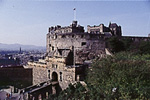 In
Edinburgh.
Tel: 0131 225 9846 In
Edinburgh.
Tel: 0131 225 9846
This most famous of castles dominates
Scotland's capital and gives stunning views of the city and countryside.
St Margaret's Chapel; the enormous 500-year-old siege cannon Mons Meg;
the Great Hall; the royal palace and the Scottish National War Memorial
are here together with the highly acclaimed "Honours of the
Kingdom" exhibition which traces the history of Scotland's Crown
Jewels and culminates in a visit to the Crown Room housing the Scottish
Regalia and the Stone of Destiny. A new shop offering an exclusive line
of specially designed jewellery is located in the adjacent Royal
Apartments. The Vaults were where foreign prisoners-of-war were held,
particularly those captured in the wars with France in the 18th and 19th
centuries. A free audio tour is available just inside the Castle.
Courtesy vehicle for disabled visitors (sponsored by the Bank of
Scotland). Restaurant offering self and table service.
Open all year seven days a week,
April to September 9.30 am to 6.00 pm. October to March 9.30 am to 5.00
pm. Last ticket sold 45 minutes before closing.
The site of Edinburgh Castle on its
glacier eroded volcanic rock mass has shown evidence of an early bronze
age earth and timber settlement.
It became a stone fortress towards the
end of the reign of Malcolm III (1058 - 1093), one of the earliest
remaining stone structures, St Margaret’s Chapel was built by David I
(1124-1153).
In 1296 Edward I of England invaded
Scotland taking Edinburgh Castle by storm.
In 1314 Sir Thomas Randolph, Earl of
Moray, led a party of thirty men who scaled the cliffs and climbed the
castle walls capturing the surprised garrison.
The castle was again held by the English
in 1335 but in 1341 Sir William Douglas and his men pretending to be
merchants entered the castle by storm, decapitating most of the garrison
and throwing their bodies over the castle walls.
In 1361 David II (1329-1371) raised a
large L shaped keep called David's Tower’ this was destroyed in the
1573 siege where Mary Queen of Scots supporters tried and failed to hold
the castle in her name.
In 1400 Henry V of England besieged the
castle but withdrew when it was reported that the Welsh under Owen of
Glendower were revolting and attacking Caerphilly Castle in South Wales.
Sir William Crichton was keeper of the
castle in 1440 when the infamous Black dinner took place. Using his
position he invited his arch-rivals the sixth Earl of Douglas and his
younger brother to dine with the king in the castle. When the great
feast was over Crichton presented the Earl a bulls head which was the
sign of condemnation to death. The king protested but to no effect, the
Douglases were taken and tried on trumped up charges of treason and
beheaded.
After 1573 the castle was remodelled and
the half moon battery built on the site of David's Tower’, this helped
defend the castle against assault in 1640 by the Covenanters, Cromwell
in 1650 and the siege by the forces of William and Mary in 1689.
In the 1720’s and 30’s the castle was
once again strengthened, this was put to the test during the Jacobite
rising in 1745. Bonnie Prince
Charlie's half hearted efforts to take the castle were the last
military action the castle saw.
See Burke's Peerage & Gentry for more information |
